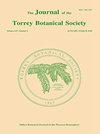阿巴拉契亚中部栎林林下植被对干扰响应的时空变化
IF 0.8
4区 生物学
Q4 PLANT SCIENCES
引用次数: 63
摘要
(美国俄亥俄大学环境与植物生物学系,俄亥俄州阿森斯45701)。阿巴拉契亚中部栎林林下植被对干扰响应的时空变化[j] .环境科学,2009(3):391 - 391。2002.研究了俄亥俄州东南部栎树为主林分的林下植被,从地形、微环境条件和采样季节等方面考察了林下植被动态和林下发展模式,探讨了管理干扰后的林下动态和林分发展模式。在不同坡向位置的上下坡上建立样地,在春季和夏季取样,以捕捉草本层动态的地形和季节变化。微立地光照、温度和土壤物理性质随林龄变化显著,而肥力和水分随坡向变化。阔叶林的物种丰富度高于成熟林分,具有更大的资源有效性和空间异质性。草本植物丰富度和丰度在朝北、朝东南的坡位和坡位较低的坡位更高,对应于较高的土壤水分和肥力。在资源丰富的空地上,也发现了更多的非本地物种。典型对应分析表明,林龄、坡向和肥力对草本层组成有显著影响。非度量的多维尺度显示出春季与夏季、采伐林地与成熟林地的成分差异。在6月份,净伐林和成熟林的组成差异显著,表明管理对夏季草本群落的影响可能更为明显。大多数关于东部森林林下植被动态的研究未能考虑到立地和植被特征的时空变化,然而,林下植被扰动响应似乎与这些生态系统特性密切相关。为了充分了解森林管理对我国东部森林草本层群落的影响,需要更好地了解这些因素。本文章由计算机程序翻译,如有差异,请以英文原文为准。
Spatial and temporal variation in the response of understory vegetation to disturbance in a central Appalachian oak forest
SMALL, C.J. AND B.C. MCCARTHY (Department of Environmental and Plant Biology, Ohio University, Athens, Ohio 45701). Spatial and Temporal Variation in the Response of Understory Vegetation to Disturbance in a Central Appalachian Oak Forest. J. Torrey Bot. 129: 136-153. 2002.-Understory vegetation in stand-initiating (7 year clearcuts) and understory-reinitiating (> 125 year mature second-growth) oak-dominated forest stands in southeastern Ohio was examined relative to topographic aspect, micro-environmental conditions, and sampling season to explore patterns of understory dynamics and stand development following management disturbance. Plots were established on upper and lower slopes across a range of aspect positions and sampled in spring and summer to capture topographic and seasonal changes in herb layer dynamics. Micro-site light, temperature, and physical soil properties differed significantly with stand age whereas fertility and moisture varied with aspect. Species richness was greater in clearcut than mature forest stands, associated with greater resource availability and spatial heterogeneity. Herb richness and abundance were greater on NWand SE-facing slopes and lower slope positions, corresponding to greater soil moisture and fertility. Greater frequencies of non-native species were also found in resource rich, clearcut plots. Canonical correspondence analysis showed stand age, aspect, and fertility to strongly influence herb layer composition. Non-metric multidimensional scaling showed compositional divergence of spring vs. summer and clearcut vs. mature forest herb samples. Composition of clearcuts and mature forests differed markedly in June, suggesting that management influences may be more pronounced in summer herb communities. Most studies of understory dynamics in eastern forests fail to account for spatial and temporal variations in site and vegetation characteristics, however, understory disturbance response appears strongly linked to these ecosystem properties. A better understanding of these factors is needed to fully understand the effects of forest management on herb layer communities in our eastern forests.
求助全文
通过发布文献求助,成功后即可免费获取论文全文。
去求助
来源期刊
CiteScore
0.70
自引率
0.00%
发文量
16
审稿时长
>12 weeks
期刊介绍:
The Journal of the Torrey Botanical Society (until 1997 the Bulletin of the Torrey Botanical Club), the oldest botanical journal in the Americas, has as its primary goal the dissemination of scientific knowledge about plants (including thallopyhtes and fungi). It publishes basic research in all areas of plant biology, except horticulture, with an emphasis on research done in, and about plants of, the Western Hemisphere.

 求助内容:
求助内容: 应助结果提醒方式:
应助结果提醒方式:


